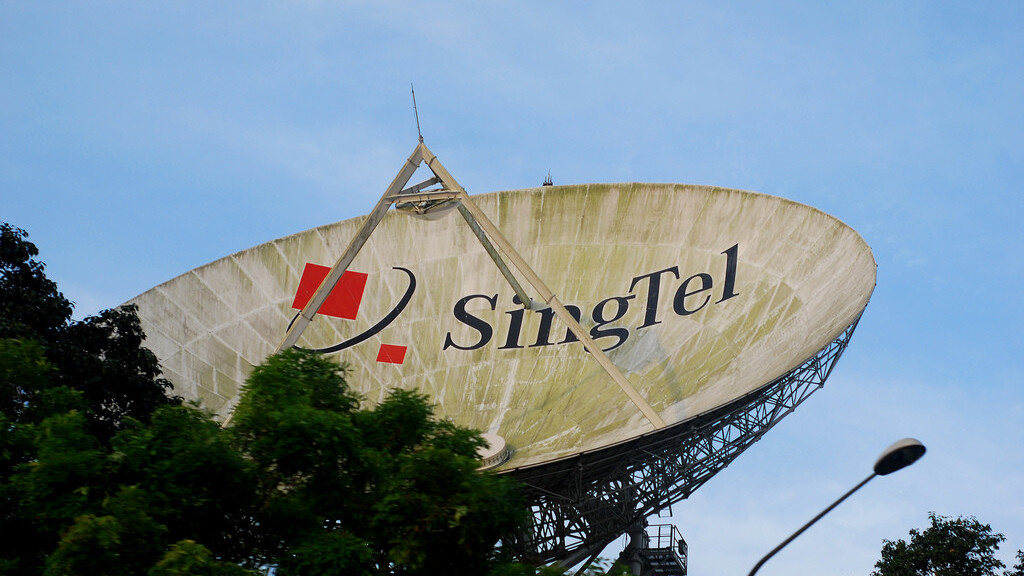
SingTel, one of the world’s largest telecom groups, has released its earnings for its fiscal third quarter, during which it says it saw “stable performance” across its businesses in Asia.
The Singapore-based group — which owns controls domestic operator SingTel and Optus in Australia, among others — saw its total customer base rise 9 percent annually to 473 million, however overall revenue fell 4.8 percent year-on-year to SG$4.597 billion (approximately US$3.72 billion).
Revenue from Singapore increased by 1.3 percent annually to reach SG$1.697 billion thanks, in part, to a series of new digital services rolled out, such as pay-per-view mobile TV service Mio. SingTel says that excluding costs for rolling out a fiber network in the country, it would have charted a 3 percent growth rate.
In Australia, where the company is restructuring its business, Optus posted quarterly revenue of AU$2.283 billion (approximately US$2.36 billion). SingTel says cost efficiencies saw Optus EBITDA increase to A$576 million, up 0.5 percent.
Among its other operators:
- Indonesia-based Telkomsel’s share of pre-tax profit increased grew 16 percent thanks to “strong growth across voice, SMS and data”.
- Thailand’s AIS added 7 percent annually to its customer base and posted a 24 percent increase in its share.
- India’s Airtel saw a 45.7 percent decrease in its share
- Globe in the Philippines saw a 7 percent service revenue increase, but its share of profits dropped 17 percent due to increased spend on marketing and subsidization.
Commenting, SingTel Group CEO Chua said that the firm is continuing to develop its business into the ‘digital era’:
We are executing our transformation plan to grow in the new digital era… The Group is focused on driving growth in mobile data services with continued investment in its infrastructure, attractive tiered data plans and meeting customer demand for higher speeds and better user experience.
Last year, SingTel stepped up its investment activity with deals to acquire Pixable for $26.5 million, advertising firm Amobee for $321 million and Yelp-like HungryGoWhere for $9.4 million.
The full (and lengthy) details from SingTel are below:
Singapore
Revenue from Singapore grew 1% to S$1.7 billion. Excluding contributions from the rollout of fiber, revenue would have grown 3%. EBITDA rose 1% on strong cost management. Excluding digital business 3, EBITDA would have grown 3%.
Mobile Communications revenue grew 3% to S$507 million on continued strong customer growth, reflecting the demand for smartphones. This was partially offset by lower roaming revenues.
SingTel added 50,000 postpaid and 13,000 prepaid mobile customers in the quarter. Since the introduction of tiered data plans in July 2012, 17% of postpaid customers as at 31 December 2012 were on such plans. Postpaid ARPU declined 6% to S$81 due to lower roaming revenue and a higher mix of data-only SIMs. Acquisition costs per postpaid customer fell 12% to S$322 due to changes in the smartphone mix.
Data and Internet revenue was stable at S$409 million. Growth in Managed Services was offset by price adjustments in leased circuits. Internet-related revenue rose 5% with increased adoption of fibre-based services and higher-tier plans.
NCS’ revenue grew 6% to S$335 million on various contracts and the delivery of the Ministry of Education contract, a program of managed desktops, network and ICT support, which was fully deployed across all schools in the preceding quarter. NCS’ order book remained strong at S$2 billion as at end December 2012.
Revenue from mio TV grew 18% to S$33 million. mio TV continues to widen the variety of its content offerings and added 7,000 customers to reach 398,000 customers as at 31 December 2012. It recently crossed the 400,000 customer milestone.
In the fibre market, SingTel maintained its lead by adding 32,000 customers, bringing the total number of fibre broadband customers 4 to 167,000 at the end of December 2012, representing a market share of approximately 60%.
Revenue from digital business was S$21 million, up from S$2 million a year ago with contribution from Amobee, our acquired mobile advertising business. These services allow us to meet customers’ needs for information and transactions, work and play situations and capture new revenue streams.
SingTel is successfully growing its presence in the homes of customers’ through its strategy of bundling fixed-line services and migrating customers onto the fibre network. Revenue from home fixed-line services 5 rose 6% to S$118 million and household ARPU grew 10% to S$50 a month. As at December 2012, 338,000 customers or 29% of households were on SingTel’s bundled plans.
Operating expenses rose 1% to S$1.18 billion and would have declined 2% excluding expenses from the new digital business. Selling and administrative expenses rose 6% due to higher customer connection costs for fibre broadband, increased maintenance and service costs to support business activities and the inclusion of digital expenses. The increase in staff costs was attributable to annual salary increments, write-back of accruals in the last corresponding quarter and the inclusion of staff costs from the digital business.
For the nine months, free cash flow grew 28% to S$1.01 billion due to improved working capital and lower tax payments.
Australia
Optus reported EBITDA growth of 3%, despite a 6% decline in revenue for the quarter. EBITDA margin improved 2.0 percentage points to 25.2% reflecting strong cost management.
Total operating expenses decreased 8%, driven by lower acquisition and retention costs and overall cost management.
In Mobile, Optus reported an increase in margin and EBITDA despite lower operating revenue. The lower revenue has not adversely impacted EBITDA, in part due to reduced traffic costs resulting from the mandated decline in mobile termination rates.
Optus continued its postpaid customer growth with net additions of 58,000 for the quarter. Postpaid customers now comprised 57% of the total base, up 3 percentage points from a year ago. Higher churn from prepaid wireless broadband products, together with reduced prepaid device subsidies, contributed to a decline in the prepaid customer base by 36,000.
During the quarter, in addition to extending its 4G coverage, 3G network performance was enhanced, with over 4,000 sites now upgraded under the U900 migration program, improving in-building coverage for customers.
In Business and Wholesale fixed, EBITDA declined 2% on lower revenues, as higher Satellite revenue was offset by lower voice and Data and IP revenues. EBITDA margin remained stable.
In the Consumer and SMB fixed business, EBITDA increased by 5% on lower traffic costs driven by lower mobile termination rates and lower operating expenses. The lower ARPU from discounted broadband plans led to a 4% decline in Consumer on-net fixed revenue. On-net broadband customers totalled 993,000 as at 31 December 2012.
Free cash flow for the nine months declined 30% to A$519 million, reflecting higher capital expenditure and higher working capital due mainly to handset receivables.
…
In January 2013, SingTel announced plans to divest its stake in Warid for a cash consideration of US$150 million and a right to receive 7.5% share of the net proceeds from any future sale, public offering or merger of Warid.
Telkomsel’s revenue increased 16% with strong growth across voice, SMS and data. In Singapore Dollar terms, the Group’s share of pre-tax profit increased 11% to S$250 million. Telkomsel’s total mobile customer base reached 125 million, up 17% from a year ago.
AIS delivered another quarter of strong performance, with growth in both voice and non-voice revenues. Non-voice revenue rose a strong 33% as mobile data usage continued to rise. It also recorded lower depreciation, amortisation and finance costs on reduced capex. In Singapore Dollar terms, the Group’s share of pre-tax profit rose 24% to S$105 million. Its customer base grew 7% from a year ago to 35.7 million.
Airtel’s pre-tax contribution to the Group declined 46% to S$70 million, mainly due to the weaker Indian Rupee, increased depreciation and amortisation, higher net financing costs and fair value losses. Airtel South Asia posted an 8% increase in revenue driven by strong voice traffic growth. However, EBITDA was flat on higher network and access charges. Airtel Africa registered a 6% growth in EBITDA from robust growth in mobile voice traffic.
Airtel’s total mobile customer base reached 251 million, up 18 million or 8% from a year ago. In South Asia, Airtel’s mobile customer base grew 7 million or 4% to 189 million from a year ago. In Africa, its mobile customers reached 61.7 million as at 31 December 2012, an increase of 10.7 million, or 21%.
Globe’s service revenue rose 7% on continued growth momentum across mobile and broadband in a competitive environment. EBITDA fell 3% as a result of higher marketing and subsidy expenses. With higher depreciation, the Group’s share of pre-tax profit declined 17% to S$31 million. As at 31 December 2012, Globe’s mobile customer base was 33.1 million, up 10% from a year ago.
Image via jjpacres / Flickr
Get the TNW newsletter
Get the most important tech news in your inbox each week.




